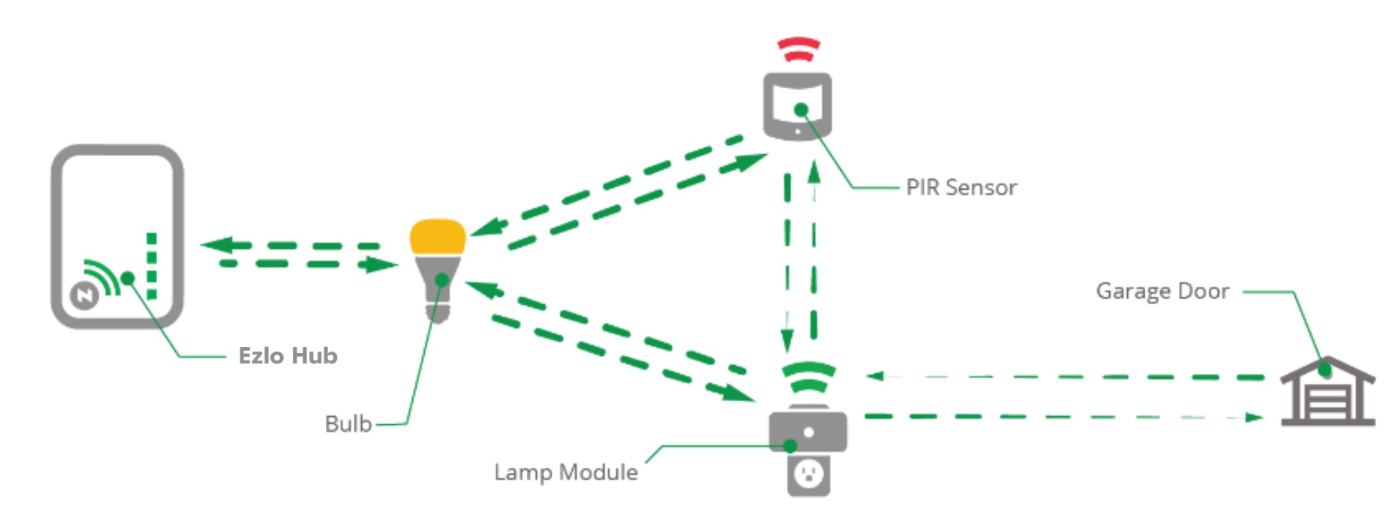Zigbee Basics
Zigbee Explained

This guide will teach you:
- What is Zigbee and how it works
- How to create your own Zigbee mesh
- What is the Zigbee range
- How to integrate Zigbee extenders into your network
- How the Zigbee range changes with different materials
What is Zigbee?
Zigbee is a wireless protocol that everyday devices like wall switches, thermostats or door locks use to connect to one another. Similar to Z-Wave, Zigbee is a standardized wireless technology, developed to enable low-cost, low-power wireless machine-to-machine and internet of things (IoT) networks.
Your Zigbee enabled Ezlo or Vera controller supports Zigbee version HA 1.2. This version adds new features that improve the battery life to more than seven years, standardizes device pairing, and simplifies installation and maintenance. Among the enhancements, it also includes support for new devices such as door sensors, smart appliances, and electrical measurement devices.
In contrast to Wi-Fi networks, Zigbee supports much lower data rates and uses a mesh networking protocol, similar to Z-Wave, to avoid interference. When Zigbee technology is used in everyday products such as lights and sensors, the products become “smart.” Smart products talk to each other, allowing you to control them from anywhere.
How does Zigbee work?
Zigbee lets smart devices connect with one another. Using routing signals, devices can perform any function you want, adding value and comfort to your home.
The Zigbee controller is responsible for storing the information while also receiving and transmitting data operations. Zigbee routing devices act as intermediary devices that allow data to pass through them to other devices.
Is Zigbee right for me?
It’s a good choice. With Zigbee, you can do the following:
- Control multiple devices from a single app
- Stay connected while you are home or away
- Use the automation features in scenes and House Modes
Picture this: It is a burning hot day. You want to cool down your home but just the thought of moving to the thermostat is dreadful. You open the Vera Mobile app and set your thermostat to cool. With one simple click, your house is a cool beach paradise. No matter where you are in the world, as long as you have internet access, The controller will receive the command and send it to your thermostat, making your house cool and comfortable.
Are you ready to start “meshing” around?

With Zigbee and your controller, long gone are the days when you had to hardwire the entire house in order to call it home automation. Zigbee is a completely automated experience with little to no wires, and certainly no headaches.
Before you go for it, here are a couple of questions you may want answered:
What is the Zigbee range?
Zigbee competes for bandwidth with high-speed protocols like Bluetooth, WiFi, and IrDA (Infrared Data Association), that are built to use every bit of bandwidth possible for applications such as voice or video transmission.
The Zigbee’s chip low power consumption limits transmission range is between 10–100 meters (30 – 330 feet) line of sight, depending on the environmental characteristics.
Note: Zigbee devices that are wall mounted in metal junction boxes will suffer a significant loss of range because the metal box blocks a lot of the Zigbee signal.
To play it safe, we recommend that you cut the range estimate to 10-meters (30-feet) if there are no obstacles in the way.
What are Zigbee range extenders?
We all know how annoying weak Wi-Fi is. If your smart home is plagued with weak wireless signals, your smart home won’t be very smart after all. A range extender can make all the difference. Range extenders capture weak or slow signals and repeat them in the rest of your Zigbee network. Most of your hardwired Zigbee nodes, such as appliance modules, bulbs, and switches, can act as repeaters on their own.
Simply plug the extender into an outlet between your Ezlo or Vera controller and your endpoint device. Doing so will allow your Zigbee bulb to piggyback off the device in order to reach your Ezlo or Vera controller:.

Is Zigbee going to work in my home?
Zigbee extenders can be used to improve the coverage and responsiveness of your mesh. However, interference and building materials might severely hinder the quality of the mesh, reducing the range by up to 70% or more, depending on the obstacles in the way.
Putting your hub in a central location and adding more repeaters can drastically improve the health of your Zigbee network. Your devices can better communicate with one another without data overloading the network.
Obstacles such as metal foiled building materials and concrete with rebar have a high reflective coefficient and reflect the Zigbee signal in undesired directions, thus decreasing the range of the transmissions.
Can Z-Wave and ZigBee devices communicate with each other?
Straight device to device, no. Zigbee and Z-Wave devices use different protocols, radio frequencies, and topologies. But that’s where your Ezlo or Vera controller comes in. The controller acts as a relay, or interpreter, between Zigbee and Z-Wave devices. So a command sent from a Zigbee device will pass through the controller which, in turn, forwards the command to the Z-Wave device.

